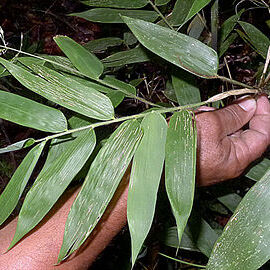Erect or clambering, often woody, perennials. Leaf-blades typically ovate. Inflorescence paniculate, monoecious, ♂ spikelets just below ♀ or lower part of panicle exclusively ♂. Spikelets 1-flowered; lodicules 2–3, truncate. Male spikelets small, fusiform, readily deciduous, lacking glumes; stamens 3. Female spikelets large, ovoid; lower glume caudate; lemma and palea crustaceous.
Spikelets monoecious, 1-flowered, deciduous, heteromorphous, with both sexes usually within the same (very rarely in different) inflorescences of each individual plant; rhachilla disarticulating below the lemma.
Glumes 2, subequal, (3)5-9-nerved, persistent, chartaceous or membranous, transversely veined, ovate to lanceolate, cymbiform, with the apex usually caudate.
Caryopsis tightly enclosed by the lemma and palea, convex on both sides; hilum almost as long as the caryopsis, linear.
Female spikelets large, conspicuous, arranged in the upper part of the inflorescence above the male ones, ventricose.
Leaf-laminae borne on a short pseudo-petiole, relatively large, somewhat asymmetric, convolute in bud, tessellate.
Palea slightly shorter than the lemma, 2-nerved, lanceolate, thinly membranous, the margins embraced by the lemma.
Palea 2-nerved, similar in shape and consistency to the lemma, tightly embraced by the margins of the lemma.
Lemma faintly 5-nerved, awnless, subcoriaceous to indurate (bony), elliptic to lanceolate, dorsally convex.
Lemma 3-nerved, membranous, broadly lanceolate, with inflexed margins, apex acuminate or shortly awned.
Male spikelets more numerous and much smaller than the female, and arranged below them, deciduous.
Glumes reduced to a very small, almost invisible rim below the articulation of the rhachilla.
Ovary glabrous; styles fused up to the middle; stigmas plumose, apically exserted.
Inflorescence a terminal panicle (rarely with some additional axillary ones).
Lodicules 3, cuneate with the apex truncate.
Lodicules usually 3, cuneate, very small.
Perennial bamboo-like grasses.
Ligules thinly membranous.
Stamens entirely absent.
Ovary completely absent.
Stamens 3.

